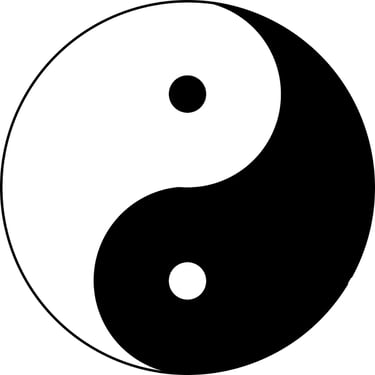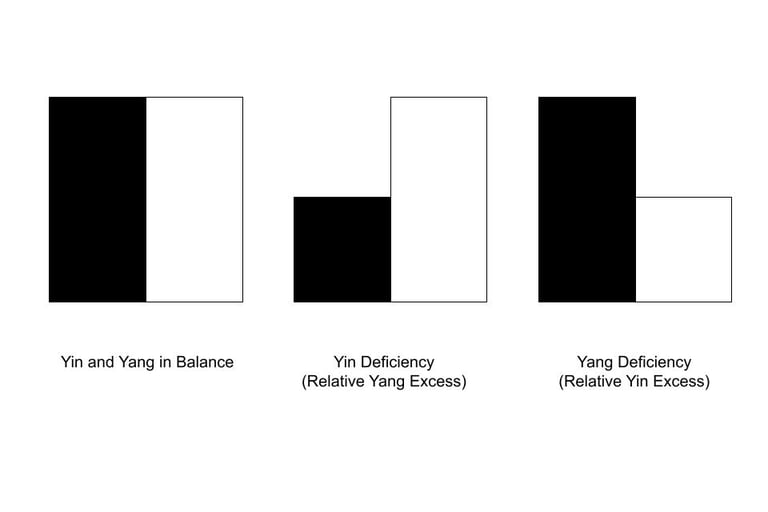Understanding Yin & Yang for Better Health
Chinese medicine developed thousands of years ago based on observations of nature and the human body. One of its most fundamental concepts is that of yin and yang, the two complementary yet opposite forces that govern our universe. They represent the feminine and the masculine, night and day, dark and light, water and fire, and so on.
These forces are often represented by an image known as the taiji (太极), or “supreme ultimate.” It depicts yin and yang moving through a neverending cycle, with one ascending until it reaches its peak, then descending again, thus allowing the other to ascend.
One of the easiest ways to understand this is by looking at the summer and winter solstices. Throughout the late winter, spring, and early summer, yang energy increases until it reaches its peak, the summer solstice. This is the most yang day of the year, as it has the longest daylight hours. From here on, yang energy steadily declines, and yin ascends until we reach the winter solstice, the most yin day of the year. Then, the cycle begins again.


Yin and yang are not separate entities but two halves of one whole, with each containing a seed of the other. This shows us that nothing can ever be completely yin or completely yang.
This is reflected by the Chinese characters yin (阴) and yang (阳), which both contain the radical for a hill or mound on their left-hand side. The second part of the character yin represents the moon, whereas the second part of the character yang represents the sun. Therefore, yin and yang can be seen as the shady and the sunny side of a mountain.
Based on these ideas, we can say that yin and yang have four key characteristics:
Complementary yet opposite forces of nature
Interdependent (one cannot exist without the other)
Mutually consuming (when one ascends, the other must decline)
Inter-transforming (when one reaches its peak, it transforms into the other)
Yin and yang also exist in the human body, and our health relies on them being in a state of constant harmony. As in nature, any disruptions to the delicate balance between yin and yang can quickly result in disease.
Yin and Yang in the Human Body
In the human body, yin and yang are responsible for form and function, rest and activity, the parasympathetic and sympathetic nervous systems, and so on. We need to maintain balance between all of these things to preserve homeostasis and, therefore, good health.
Unfortunately, it can be all too easy for the body to fall into a state of disharmony. For example, inadequate rest can lead to a yin deficiency and a relative excess of yang. Meanwhile, a lack of physical activity can cause a yang deficiency and a relative excess of yin.
Being in a constantly stressed state can increase sympathetic nervous system activity (yang) and lead to reduced parasympathetic activity (yin). Over time, this can lead to an excess of yang and a relative deficiency of yin.
Eating a diet that is too yin in nature (many cold, rich, or fatty foods) can strain the digestive system, which requires yang energy to warm it and transform food essences into qi and Blood. Over time, this can lead to an excess of yin and a relative deficiency of yang.
The term “relative deficiency” means that when yin or yang becomes excessive or deficient, the other will be affected accordingly. Although it is not a true excess or deficiency, the impact on the body may be similar.


In fact, true excesses are quite uncommon and are usually the result of an acute condition such as an infectious disease, food poisoning, heat stroke, and so on. However, deficiencies are very common, particularly as we age and our yin and yang energies naturally decline.
To read more about yin and yang deficiency, how they affect health, and what we can do to remedy them, check out the articles on yin deficiency and yang deficiency on this website.
Harmonising Yin and Yang
To remain healthy, we must work to maintain our internal balance of yin and yang. Typically, this means doing all things in moderation: eating and drinking, activity and rest, socialising and time alone. Ideally, we should also live in harmony with the ever-changing seasons, adapting our behaviour to stay aligned with the natural world.
We should also learn to recognise when the balance of yin and yang is thrown off and take corrective measures. For example, if we find ourselves sinking too far into yin, becoming tired and inactive, we may need to start warming our bodies with exercise and including more yang-nourishing foods in our diets. Likewise, if our yang becomes predominant, causing irritability and restlessness, we may need to consider calming practices like meditation and consume more yin-nourishing foods.
These are just a few ideas to help you maintain equilibrium and wellbeing. For more personalised advice, please feel free to book a consultation via the contact page of the website.
References
Maciocia G (1989) The Foundations of Chinese Medicine (first edition) - Churchill Livingstone Elsevier, London
